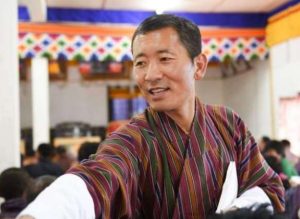
In the practice of the Dhamma, the first two factors are Right View and Right Intention. They come at the beginning and at the end of the Noble Eightfold Path in a way that may be compared to sowing a small seed: one plants the seed in the course of practice, which grows, simultaneously with all the other factors, and finally develops into a giant tree, comparable to a great oak tree, dropping seeds. Its roots are planted so firmly in the ground that, while the odd gale-force wind may shake it, no storm can uproot it.
Right View and Right Intention fall within the domain of wisdom. And, just as a tree grows from a sapling, so wisdom, through proper practice, may be said to grow from the beginning to the end of a process of mind development, through constant and ardent practice. Finally, the disciple completes the process—having done what has to be done, according to the instructions of the Buddha—finally reaching full fruition.
Full fruition is beyond comparison on the linguistic level of men and trees and solid things and forms, such as rocks and bricks and blocks. This is what the texts call the supra-mundane realm, beyond worldly perception or non-perception, which we cannot stop to examine here because it is a deeper topic than our focus at present, which we may state once again is the inside, detached view of the one who knows: the mind watching the mind.
This is an appropriate juncture to include some quotations from Bhikkhu Nanamoli (Buddhist Publication Society, Wheel Series 431–32), on the subject of Right View, both:
(i) for the sake of pulling together a summary of the factors of the Noble Eightfold Path, leading to the end; and
(ii) for explaining the apparent paradox of why Right View is always said to be both the beginning and end of the path.
From the Sammaditthi Sutta on Right View, Bhikkhu Nanamoli translates:
“Bhikkhus, just as the dawn is the forerunner and first indication of the rising of the sun, so is right view the forerunner and first indication of wholesome states.
“For one of right view Bhikkhus, right intention springs up.
(Anguttara Nikaya 10:121)
For one of right intention, right speech springs up.
For one of right speech, right action springs up.
For one of right action, right livelihood springs up.
For one of right livelihood, right effort springs up.
For one of right effort, right mindfulness springs up.
For one of right mindfulness, right concentration springs up.
For one of right concentration, right knowledge springs up.
For one of right knowledge right deliverance springs up.”
These are the words of the Buddha, the one who knows how to clear the path. The end of the process seems to be stated clearly in the above reading, at least in common language.
In the end, one who has practiced the factors of the path according to the Buddha’s instructions—through direct application and experience, with proper diligence and right effort—proceeds to the point of cultivating Right Knowledge and attains the wisdom that clears and opens the path to deliverance from suffering.
Following Bhikkhu Nanamoli’s translation of the wording that Venerable Sariputta uses in the same sutta on Right View, we have a picture of what it means to travel the figurative arc of the sun in the simile from the first dawning of awareness to a perception of fully arisen awareness with regard to nutriment in the process of liberation.
A bhikkhu asks Ven. Sariputta:
“But friend, might there be another way in which a noble disciple is one of right view . . . and has arrived at this true dhamma?”
“There might be friends.”
“When friends the noble disciple understands nutriment, the origin of nutriment, the cessation of nutriment, and the way leading to the cessation of nutriment, in that way, he is one of right view . . . and has arrived at this true Dhamma.
“And what is nutriment and what is the origin of nutriment? What is the cessation of nutriment? What is the way leading to the cessation of nutriment?
“There are these four kinds of nutriments for the maintenance of beings that have already come to be and for the support of those seeking a new existence. What four? They are physical foods as nutriment, gross or subtle; contact as the second; mental volition as the third; and consciousness as the fourth. With the arising of craving, there is the arising of nutriment.
“With the cessation of craving, there is the cessation of nutriment; the way leading to the cessation of nutriment is just this Noble Eightfold Path; that is right view, right intention, right speech, right action, right livelihood, right effort, right mindfulness, right concentration.
“When a noble disciple has thus understood nutriment, the origin of nutriment, the cessation of nourishment, and the way leading to the cessation of nourishment, he entirely abandons the underlying tendency to greed.
“He abolishes the underlying tendency to aversion; he extirpates the underlying tendency to the view and conceit, ‘I am’ and by abandoning ignorance and arousing true knowledge, he here and now makes an end of suffering.
“In that way too a noble disciple is one of right view, whose view is straight, who has perfect confidence in the Dhamma, and has arrived at this true Dhamma.”
This about sums it up. The only thing that remains is to try to do it yourself, in order to develop knowledge based on direct experience. No one can do it for you, but if you are one of the few who can make the concentrated effort, you can attain this yourself.
References
Bhikkhu Ñāṇamoli. 1991. The Discourse on Right View: The Sammādiṭṭhi Sutta and its Commentary Translated from the Pali. Edited and Revised by Bhikkhu Bodhi. The Wheel Publication No: 377–79. Kandy: Buddhist Publication Society
Related features from BDG
The Way of Mindfulness
Doing What Has to Be Done
On Right Intention and Right Action













Wishing YOU well in sharing insights and dialogue for clarity and understanding.